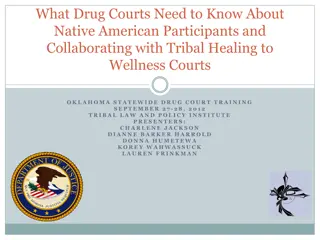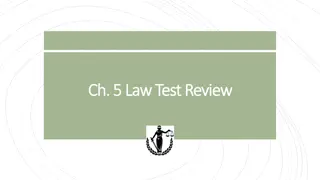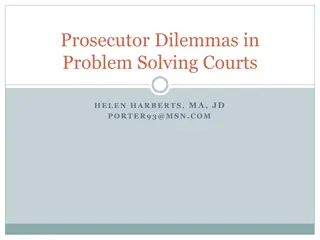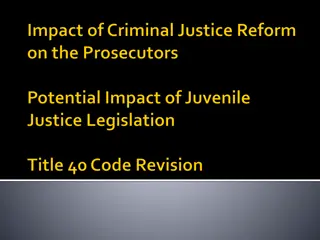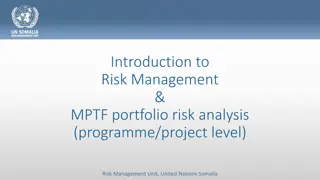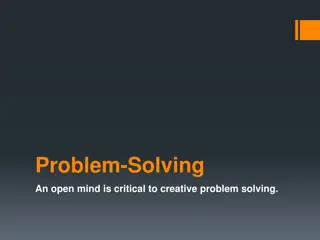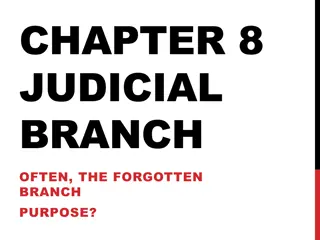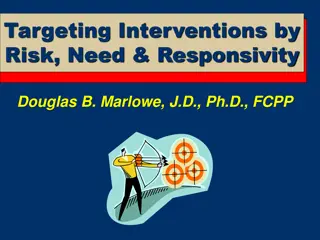Evidence-Based Practices and Risk-Need-Responsivity in Problem-Solving Courts
Evidence-Based Practices (EBPs) are approaches proven to reduce recidivism and improve outcomes in problem-solving courts. Risk-Need-Responsivity theory has helped reshape rehabilitation strategies. This presentation delves into established EBPs, the importance of RNR, and its application in enhancing crime prevention efforts.
Download Presentation

Please find below an Image/Link to download the presentation.
The content on the website is provided AS IS for your information and personal use only. It may not be sold, licensed, or shared on other websites without obtaining consent from the author. Download presentation by click this link. If you encounter any issues during the download, it is possible that the publisher has removed the file from their server.
E N D
Presentation Transcript
Evidence Based Practices and Risk-Need-Responsivity The Problem Solving Court Context Sarah Fritsche, Center for Court Innovation Presented at the 2014 Oklahoma Specialty Court Conference, Norman, OK, September 11, 2014 1
Defining Evidence Based Practice Everyone is asking for them, so what are Evidence Based Practices? Evidence-Based Practices (EBPs) are approaches which have been empirically researched and proven to have measureable positive outcomes. In the context of problem solving courts, this typically means they reduce general recidivism, but other indicators of success include incarceration reductions, reduced costs or increased efficiency, community restoration, and improved social or health outcomes. 2
Established EBPs While a great deal of attention has been paid to Risk- Need-Responsivity (RNR) in recent years, there is an established tradition of other evidence based practices in problem solving courts: o Procedural Justice o Focused Deterrence Efforts o Collaboration 3
Why the Hype about RNR? Beginning in 1970s, a trend in criminological thinking that nothing works to rehabilitate offenders took root, as reflected in this famous quote by Robert Martinson: With few and isolated exceptions, the rehabilitative efforts that have been reported so far have had no appreciable effect on recidivism our present strategies cannot overcome, or even appreciably reduce, the powerful tendencies of offenders to continue in criminal behavior. (Martinson, 1974) Risk-Need-Responsivity theory has played a central role in discrediting the nothing works perspective, and thereby revitalizing the movement for rehabilitation. 4
Todays Agenda Besides an evidence based practice, what is Risk-Need-Reponsivity ? o Risk-Need-Responsivity Theory (RNR) Evolution and Defining Principles of RNR theory A closer look at risk, need, and responsivity o Risk and Need Principles in Practice Evidence Based Screening and Assessment Applying assessment results to supervision & treatment o Cautionary Notes Applying RNR in context
Risk Need Responsivity Theory Risk need responsivity theory is based primarily on theories of behavioral psychology and is intended to support efforts at crime prevention through providing services targeted toward individual criminogenic risk factors. Within the social science literature, criminogenic simply means that the need or risk factor has been statistically associated with future offending. 6
Risk-Need-Responsivity Principles o Risk Principle Match the level of service to the individual s risk to re-offend. There is growing support in the research for reserving treatment resources for higher risk offenders. o Need Principle Assess each person for known criminogenic needs and target treatment based on their most salient needs. o Responsivity Principle Maximize the potential success of rehabilitative intervention by providing cognitive behavioral treatment and tailoring the intervention to the learning style, secondary needs, motivation, and strengths of the offender.
A Closer Look at the Risk Principle Risk Principle: Vary treatment intensity by risk (defined as risk of re-offending absent intervention). High- or Medium-Risk: Target for intensive treatment. Low-Risk: Use less intensive intervention. Treatment can be counter-productive: o Removes offenders from work and school o Surrounds offenders with moderate or high risk peers, while potentially removing them from low risk peers o Deepens criminal justice involvement (potential for negative labeling and negative effects on self-concept)
Why is assessing criminogenic risk so important? 9
Multisite Ohio Study: High-Risk Treatment Effects For High Risk Offenders 40 34 32 30 30 27 2425 2122 Probability of Reincarceration 20 15 12 12 1213 13 13 10 10 9 8 8 10 7 6 5 3 3 3 2 0 -2 -2 -6-5 27 of 35 programs produce positive effects -10 -15-14 -20 -18 -30 -34 -40 Cincinnati VOA McMahon Hall NEOCAP Oriana House RIP Lorain/Medina Lucas County SRCCC All Facilities Licking/Muskingum Butler SEPTA Small Programs Oriana House TMRC Cincinnati VOA Chemical Dependency Program Alvis House Alum Creek Comp Drug Harbor Light Salvation Army Community Corrections Association Toledo VOA EOCC Alternative Agency Talbert House Cornerstone Monday WORTH Canton Community Treatment Center Summit County Franklin County Talbert House Beekman River City Fresh Start Talbert House Spring Grove Alvis House Dunning Hall All CBCF Facilities Community Transitions Mahoning County Community Assessment Program (Men s) Note: Data from Lowenkamp, C. T., and Latessa, E. J. 2002. Evaluation of Ohio s Community Based Correctional Facilities and Halfway House Programs. Cincinnati, OH: University of Cincinnati. Source for Slide: Latessa (2011)
Multisite Ohio Study: Low-Risk 23 of 34 programs produce negative effects Note: Data from Lowenkamp, C. T., and Latessa, E. J. 2002. Evaluation of Ohio s Community Based Correctional Facilities and Halfway House Programs. Cincinnati, OH: University of Cincinnati. Source for Slide: Latessa (2011)
New York Drug Courts: Risk Level Effect Size by Offender Risk Level: Difference in Three-Year Re-Arrest Rate 10% 9% 8% 6% 4% 2% 0% Quintile 1: Low Risk Quintile 4: High-Risk -2% -3% -4% Source for Slide: Cissner et al. (2012)
What are the Known Criminogenic Risk factors? Criminogenic Risk and Need Factors (the big 8 ) 5. Substance Abuse (dynamic) 6. School/Work Failure (dynamic) 7. Family or Relationship Problems (dynamic) 8. Lack of Pro-social Activities (dynamic) 1. Criminal History (static) 2. Antisocial Personality Pattern (dynamic ) Pro-criminal Attitudes (dynamic) Social Supports for Crime (dynamic ) 3. 4. 13
A Closer Look At the Need Principle Need Principle: Assess and target criminogenic needs for treatment needs that, if left unmet, lead to criminal re- offending. Returning to the Big 8 what can/should be treated? (in theory everything except criminal history): Criminal Thinking, Antisocial Personality Pattern, Social Supports for Crime, Substance Abuse, School or Work Problems, Family or Marital Problems, Lack of Pro- Social Recreation. 14
Evidence-based Interventions Cognitive-behavioral interventions have been shown to be effective treatment for criminal thinking, antisocial behavior patterns and other criminogenic needs including substance abuse. CBT Interventions Focus on: The Present: current people, places, and behaviors Thinking Errors: external locus of control, sense of hopelessness, sense of victimization Cognitive Restructuring: effort to disrupt the automatic thoughts & feelings that lead to (e.g.) crime and drug use A recent Meta-Analysis* found moderate to strong effects for commonly used CBT interventions such as Reasoning and Rehabilitation and Thinking for Change. * *See Lipsey, M.W., Landenberger, N. A.Wilson, S.J. (2007). Effects of Cognitive-Behavioral Programs for Criminal Offenders. Oslo, Norway: Campbell Collaboration.
A Closer Look at the Responsivity Principle Even they don t make the Big 8, there are many other needs that greatly affect individual well-being and can mitigate the effectiveness of intervention. The importance of assessing and treating these needs is acknowledged by the responsivity principle. Mental Illness Trauma history Cognitive or Developmental problems The responsivity principle also recommends we consider strengths in our program development such as motivation for change, different learning styles and strong social supports for recovery.
Evidence Based Screening and Assessment o Evidence-based Assessment is typically a 2-step process. Step 1: A short screen is conducted to identify overall risk-level and to flag primary criminogenic needs. Step 2: If the defendant/offender flags on some dynamic needs, longer assessment may be indicated. o The two step nature of assessment is particularly important for the court context, given time and resource constraints. 17
Selecting Evidence-based Tools Things to keep in mind Previously validated instruments (like LSI-R and COMPAS) provide immediate capacity to reliably sort offenders into risk categories, but also have their downsides (long, proprietary, developed for specific populations). Some assessment systems offer separate screeners and full assessments. Validated vs. Evidence Based and Domains vs. Questions -- what really matters? Consider the pros and cons of adopting/adapting an instrument already in use by local justice system or community partners. Consider a research/practitioner for dynamic assessment purposes. 18
Selecting Evidence-based Tools What does validated mean and which tools qualify? See assessment digest for details . o RANT: Risk and Needs Triage (TRI, 2009) oThe Level of Services Inventory (LSI-R) (Andrews and Bonta, 1994) oCorrectional Offender Management Profiling for Alternative Sanctions (COMPAS) (Northpointe, Inc. 2000s) oOhio Risk Assessment System (ORAS) (University of Cincinnati, early 2000s) oTexas Christian University Screening Tools (Various) 19
Integrating Assessment Results into Case Management and Treatment Planning o Apply the risk principle (i.e., reserve most intensive supervision and treatment for high risk clients). Important for court settings: this process usually includes education across court stakeholders and staff to establish buy-in. o Assess for the availability and feasibility of integrating CBT or other evidence based programs into court practice. o Partner with treatment agencies. 20
Cautionary Notes o Evidence based practice is sensitive to local context o This applies to RNR, as well as to other EBPs o Specific to RNR: need for local validation and resource mapping o Common misunderstandings regarding evidence-based practice and assessments o The Ecologoical Fallacy (group versus individual prediction) o Validated assessment tools should or will completely replace professional judgment. o Non-criminogenic factors are not relevant to correctional treatment. 21
Risk-Need Assessment Research at the Center for Court Innovation o Evidence-based Assessment in Drug Courts (study of the LSI-R) o Validity of the COMPAS assessment in MH Courts o Risk Assessment for Police-led Diversion o Misdemeanor Evidence-based Assessment ( MEBA ) Includes intervention development and evaluation 22
Q & A Direct further questions to: Sarah Picard-Fritsche fritsches@courtinnovation.org 646-386-5911 23
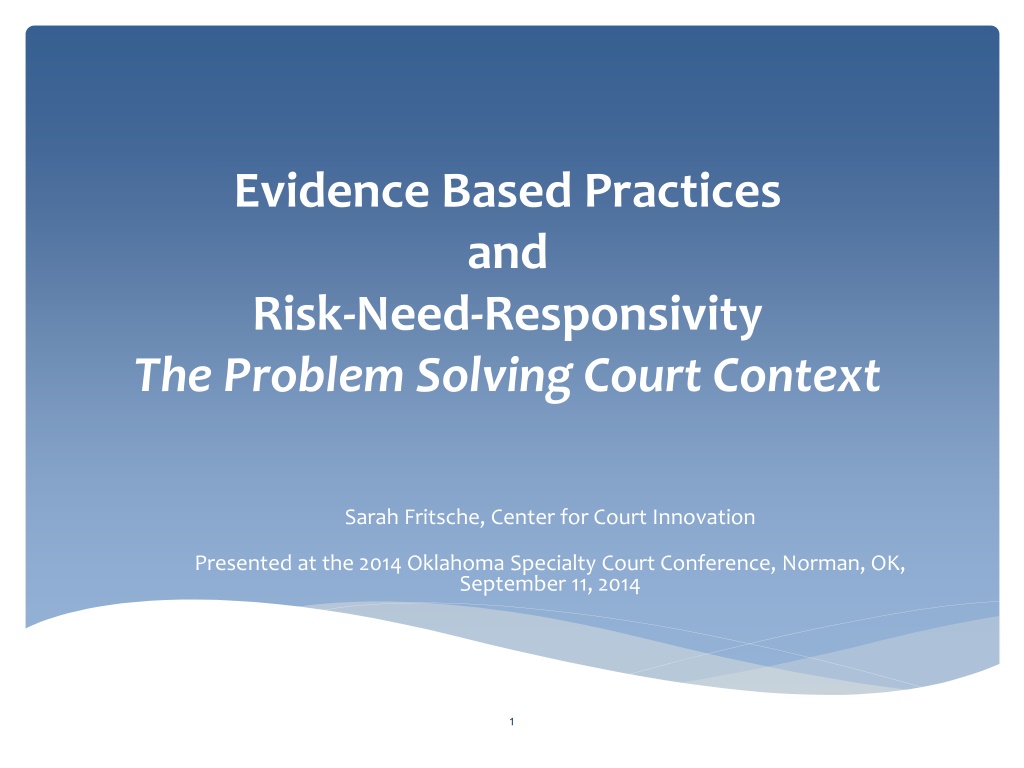
 undefined
undefined

 undefined
undefined






